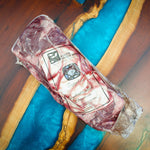
Chapter 9: Brahman
In the warm embrace of tropical climates, where the sun casts its golden glow over sprawling landscapes, Brahman cattle roam—a breed that stands as a testament to resilience and heat tolerance. With their distinctive humps and loose-hanging skin, Brahman cattle have carved a niche in American agriculture, thriving in conditions that might challenge other breeds.
Tropical Roots and Distinctive Features:
The Brahman breed traces its roots to the Indian subcontinent, where it evolved in the heat and humidity of tropical regions. Introduced to the United States in the 19th century, Brahman cattle quickly adapted to the challenging conditions of the American South, proving their mettle in withstanding heat, humidity, and insects.
One of the hallmark features of Brahman cattle is the distinctive hump on their shoulders. This hump, composed of muscle and a fibrous pad, serves as an adaptation to heat. It allows Brahman cattle to regulate their body temperature more efficiently, making them well-suited to hot climates.
Heat Tolerance and Adaptability:
Brahman cattle are renowned for their remarkable heat tolerance, a quality that has made them invaluable in regions with high temperatures. Their ability to thrive in hot and humid conditions, where other breeds might falter, positions Brahman cattle as a preferred choice for farmers and ranchers in tropical and subtropical climates.
The loose-hanging skin of Brahman cattle further contributes to their adaptability. This skin, covered in sweat glands, aids in heat dissipation, allowing Brahman cattle to stay cooler in warm weather. The adaptability of Brahman cattle extends beyond heat tolerance to resistance against common tropical diseases and parasites.
American Influence and Versatility:
Brahman cattle quickly found a home in the United States, where their resilience and adaptability were highly valued. The breed's influence has extended beyond heat tolerance to include traits such as hardiness, fertility, and efficient forage utilization.
In addition to their role in beef production, Brahman genetics are frequently incorporated into crossbreeding programs. The influence of Brahman genes contributes to enhancing traits such as heat tolerance and disease resistance in diverse cattle herds.
Culinary Considerations and Beyond:
While Brahman cattle are primarily known for their adaptability to tropical climates, their meat is also appreciated for its unique qualities. Brahman beef is often characterized by its leanness and tenderness, making it a favored choice in certain culinary contexts.
Beyond the culinary arena, Brahman cattle have become an integral part of the cultural and economic fabric of regions where heat and humidity define the agricultural landscape. Their resilience, combined with their versatility, makes them valuable contributors to sustainable and productive farming practices.
Conclusion: Brahman—The Heat-Resistant Titans:
As Brahman cattle graze under the warmth of the tropical sun, they stand as heat-resistant titans, embodying the fusion of Indian heritage and American adaptation. Their distinctive features, from the hump on their shoulders to the loose-hanging skin, tell a tale of resilience in the face of challenging climates. Brahman cattle are not just livestock; they are partners in agriculture, helping to transform landscapes and pave the way for sustainable and efficient farming in regions where the sun's embrace is both a challenge and a blessing.





